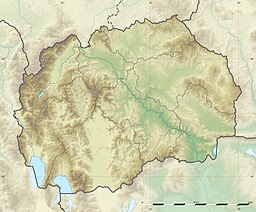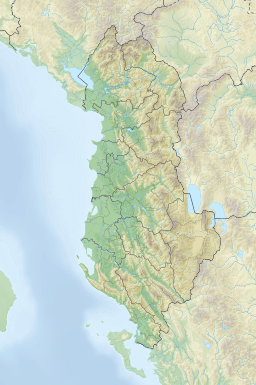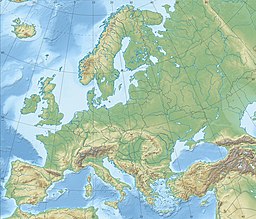
Back بحيرة أوخريد Arabic Llagu d'Ohrid AST Balkan yarımadası gölləri Azerbaijani Ахрыдскае возера Byelorussian Охрыдзкае возера BE-X-OLD Охридско езеро Bulgarian Ohridsko jezero BS Llac d'Okhrida Catalan Lake Ohrid CEB Ochridské jezero Czech
| Lake Ohrid | |
|---|---|
 Lake Ohrid viewed from a NASA satellite | |
 Map of the Ohrid Basin showing major hydrological and geological features | |
| Location | North Macedonia–Albania border |
| Coordinates | 41°2′N 20°43′E / 41.033°N 20.717°E |
| Lake type | ancient lake, tectonic lake |
| Primary inflows | Sateska River, Biljana's springs, underground link with Lake Prespa |
| Primary outflows | Black Drin River |
| Catchment area | 2,600 km2 (1,000 sq mi) |
| Basin countries | North Macedonia, Albania |
| Max. length | 36.4 km (22.6 mi) |
| Max. width | 16.8 km (10.4 mi) |
| Surface area | 358 km2 (138 sq mi) |
| Average depth | 155 m (509 ft) |
| Max. depth | 288 m (945 ft) |
| Water volume | 55.49 km3 (13.31 cu mi) |
| Residence time | 70 years |
| Shore length1 | 87.53 km (54.39 mi) North Macedonia: 56.02 km (34.81 mi); Albania: 31.51 km (19.58 mi) |
| Surface elevation | 693 m (2,274 ft) |
| Islands | none |
| Settlements | Ohrid, Struga (North Macedonia) Pogradec (Albania) |
| Official name | Natural and Cultural Heritage of the Ohrid region |
| Type | Natural, Cultural |
| Criteria | i, iii, iv, vii |
| Designated | 1979 (3rd session) |
| Reference no. | 99 |
| Region | Europe and North America |
| Extensions | 1979, 2019 |
| Designated | 15 February 2021 |
| Reference no. | 2449[1] |
| 1 Shore length is not a well-defined measure. | |
Lake Ohrid (Macedonian: Охридско Езеро, Ohridsko Ezero, [ˈɔxridzkɔ ˈɛzɛrɔ]; Albanian: Liqeni i Ohrit [liˈcɛni i ˈɔhrit]) is a lake which straddles the mountainous border between the southwestern part of North Macedonia and eastern Albania. It is one of Europe's deepest and oldest lakes, with a unique aquatic ecosystem of worldwide importance, with more than 200 endemic species.[2]
North Macedonia's side of Lake Ohrid was declared a World Heritage Site by UNESCO in 1979, with the site being extended to also include the cultural and historic area of Ohrid in 1980. In 2010, NASA named one of Titan's lakes after it.[3] In 2014, the Ohrid-Prespa Transboundary Reserve between Albania and North Macedonia was added to UNESCO's World Network of Biosphere Reserves.[4] Albania's side of Lake Ohrid was also designated UNESCO world heritage status in 2019. North Macedonia's portion was designated as a protected Ramsar site in 2021, passing all nine criteria for proclamation.[5]
In Albania, the coastal portion of the lake holds Managed Nature Reserve status. In North Macedonia, a portion of the lakeside is part of the Galičica National Park.
The towns situated at the lakeside are Ohrid and Struga in North Macedonia along with Pogradec in Albania. The lake is otherwise surrounded by settlements in the form of villages and resorts in both basin countries.
- ^ "Lake Ohrid". Ramsar Sites Information Service. Retrieved 13 May 2021.
- ^ "Lake Ohrid; Invest in Macedonia – Agency for Foreign Investments of the Republic of Macedonia". InvestInMacedonia.com. Archived from the original on 14 September 2008. Retrieved 3 June 2017.
- ^ "One of Titan lakes to be named Ohrid Lacus". MIA.com.mk. Retrieved 3 June 2017.
- ^ "Single View News - United Nations Educational, Scientific and Cultural Organization". www.UNESCO.org. Retrieved 3 June 2017.
- ^ Ministry of Environment and Physical Planning (2021) "Ramsar Information Sheet: Lake Ohrid". Ramsar Secretariat, Gland, Switzerland.



